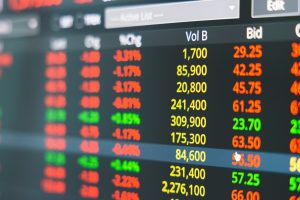Delinquency levels spike in commercial real estate … 83% of loans won’t be able to refinance at current levels … “Extreme Greed” is driving stocks today … the Nasdaq 100 is stretched thin
On Monday, the latest warning shot from the commercial real estate sector sailed across the bow.
From Trepp Research:
CMBS [Commercial mortgage-backed securities] investors and market participants have been waiting for months for delinquencies to spike.
Since last summer, higher rates and lagging office demand have led to expectations of substantially higher delinquency levels.
It appears that the tipping point came this month.
In May 2023, the overall CMBS delinquency rate shot up 53 basis points to 3.62%. The rate is the highest level since March 2022…
The increase in May 2023 was driven by a huge spike in office delinquencies. The office rate jumped 125 basis points to 4.02%.
The last time the office rate was above 4% was 2018. At that time, many loans originated in 2006 and 2007 were still outstanding accounting for the high level. That is not the case currently.
Regular Digest readers know that for months, we’ve been running a “commercial real estate watch” segment to monitor this critically-important sector of the U.S. economy.
The same factors that resulted in a handful of banking failures this spring are creating cracks in the foundation of the $20-trillion commercial real estate sector. If defaults snowball, it will have an enormous impact on the U.S. economy.
It appears the snowball is now barreling down the hill, picking up speed and growing
For context, about $1.5 trillion in commercial mortgages are coming due over the next three years. Many of these loans are “interest only.”
With this type of loan, the borrower pays only interest throughout the entire life of the loan. There’s no build-up of equity, so the entire principal payment comes due at the end.
Of course, in normal times, this is fine. After all, low vacancy rates and healthy rent levels enable the borrower to cover the interest-only payments easily enough. And over time, the value of the underlying real estate appreciates, so the borrower can pay the entire principal back and, hopefully, enjoy some profits left over.
But thanks to the Fed’s soaring interest rates, a surge in office vacancies after Covid, and crumbling rental rates/property values, these are not normal times.
Worse, the number of real estate investment groups using interest-only loans has exploded in recent years which makes everything riskier.
According to Trepp, back in 2013, interest-only loans as a share of new commercial mortgage-backed securities issuance clocked in at just 51%.
By 2021, that percentage had exploded to 88%.
This is a recipe for major fallout.
Here’s The Wall Street Journal:
Fitch Ratings recently estimated that 35% of pooled securitized commercial mortgages coming due between April and December 2023 won’t be able to refinance based on current interest rates and the properties’ incomes and values.
While many malls and hotels face high default risks, the situation is particularly dire for office owners.
Xiaojing Li, managing director at data company CoStar’s risk analytics team, estimates that as much as 83% of outstanding securitized office loans won’t be able to refinance if interest rates stay at current levels…
A rise in defaults could ripple through the commercial real-estate market by forcing distressed sales and pushing down property values.
It could also hit regional and community banks that are heavily exposed to the sector, forcing them to write down the value of commercial mortgages on their books and set aside more cash to cover for losses.
We continue to urge you to be aware of how much exposure your portfolio has to both commercial real estate and regional banking. More pain is coming for both sectors.
Despite this, as we look at the stock market, investor sentiment has turned to greed, money is pouring into tech stocks, and momentum appears stretched – but don’t ignore AI
Let’s look at each of these points.
As to investor sentiment, here’s the CNN Fear & Greed Index, which reflects the dominant emotion driving market activity.
As you can see, “Extreme Greed” wins the day.
As to money flows into tech, according to EPFR Global data, tech funds attracted $8.5 billion in the week through May 31 – that’s an all-time high.
In a recent note to clients, Bank of America Global Research analysts wrote that investors are chasing a “summer rip tide into tech and stocks” and that the market is “bored of waiting for rates to cause a recession.”
It is quite the “rip tide.”
We can see this in two ways. First, the Bank of America analysis calculates that just seven stocks collectively account for 8.8 percentage points of the S&P’s 10% return in 2023. Those seven stocks are:
- Apple
- Microsoft
- Google parent Alphabet
- Amazon
- Nvidia
- Meta
- Tesla
Do you see a theme?
Artificial Intelligence (AI).
On that note, last night, our technology expert Luke Lango held a special live event that dove into the enormous opportunity unfolding in tech/AI right now. Frankly, the number of investors who watched Luke’s presentation blew us away.
And for good reason – people realize that we’ve arrived at a watershed moment, both in terms of AI’s impact on our culture as well as on the investment markets. This is not a fad or hype. This is a line-in-the-sand.
To watch a free replay of last night’s event that’s filled with Luke’s research, just click here. This is a must-watch for any investor wanting to capitalize on AI – and no, Luke isn’t suggesting investors buy into the obvious names like Nvidia.
In fact, the recent investor stampede into Nvidia that has pushed its valuation to an outrageously expensive level dovetails into our next point…
As to the second way we see investors flooding into tech, let’s look at the Nasdaq 100’s Relative Strength Indicator (RSI)
This is a momentum indicator that measures the extent to which an asset is overbought or oversold. A reading over 70 suggests an asset is “overbought” (and likely poised to pull back) while a reading below 30 means it’s “oversold” (and poised for positive gains).
The Nasdaq 100, which has surged 33% this year, is now deep in “overbought” territory, and has been for nearly two weeks.
As you can see below, as I write on Wednesday, its RSI comes in at more than 73. Yesterday, it was more than 75.
Now, two things can be true at once…
One, AI stocks can – and will – power a wave of extraordinary investment gains this decade.
Two, even AI stocks will need occasional breathers when the bullish enthusiasm grows overheated. And based on the Nasdaq 100’s red-hot RSI levels, it’s growing increasingly likely that some degree of consolidation is in the near-future.
The Nasdaq 100 itself provides us a case study for this
Let’s look again at the same Nasdaq 100 chart from above.
This time, however, we’ll highlight the only other time in 2023 when the RSI reading reached overbought levels, and then we’ll look at what happened to the Nasdaq 100’s price afterward.
After barely reaching overbought conditions in early February, and spending virtually zero time at that level, the Nasdaq 100 fell 7.6% until reaching a localized bottom in March.
Today’s RSI level is substantially more overbought than the level in February and has been so for almost two weeks now. While that doesn’t necessarily mean we’ll suffer a larger drop in the market, investors should be mentally prepared for such an outcome.
But beware of letting this scare you away from tech/AI today
Yes, the Nasdaq 100 is stretched. And yes, Nvidia trades at a nosebleed valuation, as do some other hyped AI stocks.
But in the same way that investors need to be careful about not putting money into certain AI stocks today, they need to be just as careful about letting fear prevent them from making any AI investments.
We’re at the beginning of the AI boom. This is the time to put money to work. And sure, there will be volatility. But for the right AI stocks, the volatility is worth it, as the long-term payoff stands to be on par with the most lifechanging returns we saw from the Dot Com boom.
So, how do you sift the good from the bad within the AI sector?
Well, a fantastic start is Luke’s free presentation from last night. You’ll walk away with a vastly better awareness of this AI opportunity and how to play it.
Big picture, we’ll continue to keep you updated on both commercial real estate and the AI sector here in the Digest.
Have a good evening,
Jeff Remsburg








